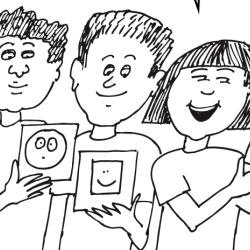Source Institutions
Source Institutions
Add to list Go to activity
Activity link broken? See if it's at the internet archive

In this game (on pages 14-21), learners explore how each human being inherits genetic traits such as eye color. Learners use "Smiley Mother's Genes" cards and "Smiley Father's Genes" cards to "mate" them into a Smiley Face Baby that the learner draws. The Mating Game Results page shows how the pairs translate into features such as face, eye, and mouth shape, skin color, hair type, and sex. The Thinking It Over section asks questions about how learners would feel if their baby had "Upsidedown Smile Syndrome," which can open up a discussion about genetic engineering.
- 10 to 30 minutes
- 30 to 45 minutes
- $1 - $5 per group of students
- Ages 8 - 14
- Activity, Game
- English, Spanish
Quick Guide
Materials List (per group of students)
- scissors
- pencil
- crayons, markers, or colored pencils (yellow, orange, and blue)
- tape or glue
- 1 copy of Smiley Mother’s Genes (p. 16) on colored paper
- 1 copy of Smile Father’s Genes (p. 17) on different colored paper
Subjects
-
Engineering and Technology
-
Engineering
- Bioengineering/Biomedical Engineering
-
Engineering
-
Life Sciences
-
Heredity and Genetics
- Patterns of Heredity
- Human Genetics
- Genetic Engineering
-
Heredity and Genetics
-
The Nature of Technology
-
Technology and Society
- Impacts of Technology
-
Technology and Society
Informal Categories
- Games
Audience
To use this activity, learners need to:
- see
- see color
Learning styles supported:
- Involves teamwork and communication skills
- Involves hands-on or lab activities
Designed specifically for
- Rural dweller
Culture, ethnicity, and gender
-
Girls
- Explicity developed for this group
Other
Foreign language versions of this resource:
Components that are part of this resource:
Includes alignment to state and/or national standards:
This resource is part of:
Access Rights:
- Free access
By:
Source Collection
- Science After School Consumer's Guide
Rights:
- All rights reserved, University of Nebraska State Museum and Nebraska 4-H, 2002
Funding Sources:
- National Science Foundation Informal Science Education Program, 9909496
- Howard Hughes Medical Institute
